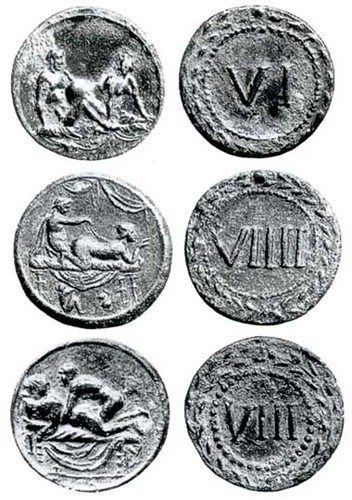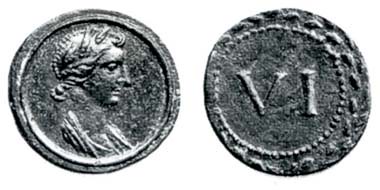
PREV ARTICLE
NEXT ARTICLE
FULL ISSUE
PREV FULL ISSUE
SPINTRIAE ARE NO BROTHEL TOKENSRegarding the recent publicity around the discovery in London of what was dubbed a brothel token, Ursula Kampmann, editor of Coins Weekly writes: Just one remark, because I have been trying to overcome this 19th century opinion for years and years and years. Spintriae are no brothel tokens. This was notion was invented in a time everything was dirt when it was connected with the sexual interaction between woman and man. Here you will find an article on a much more probable purpose. It is certainly not my research which has revealed this background, but a great article by Ted Buttrey, which unfortunately is only scholarly and not as sexy as calling these things brothel tokens again and again and again. Thank you once again for your brilliant newsletter, which is always very inspiring. It's incredible how fast you receive all this information. You have to be proud of your readership informing you on all these issues.
Indeed. Our readership is among the best in the world, and we can always count on someone to come forth and set things straight when we're led astray. I hadn't heard the term "spintriae" until this week. Here's an excerpt from Ursula's Coins weekly with some illustrations. Be sure to follow the link to read the complete version. Thanks!
-Editor
Spintriae are highly popular and expensive collectibles, but what purpose did they actually serve in Antiquity? One has to pay high prices indeed for the so-called spintriae - brothel tokens as one is secretly whispered to. There are experts who know exactly what the function of these objects was: they were bought at the brothel's entrance. The representations had to be regarded as a kind of catalogue of pleasures on offer in that particular brothel. After choosing a position one went into the chamber whose number the token's reverse stated and the beauties - which mostly came from exotic countries - were instantly informed about their customers' desire. Today, the spintriae have become treasured collectibles. The slightly indecent, crackerbarrel-like odour still sticks to them, to these small works of art which exercise no restraint whatsoever in showing the sexual act.

The first person that associated the spintriae with sex was a numismatist called Spanheim who published a treatise on numismatics in 1664. He invented the term "spintriae" for the small bronze pieces that surely were called different in Antiquity. He took it from Tacitus' Annals which describe the reign of Tiberius; that emperor, which - if we are inclined to follow Suetonius and Robert Ranke Graves, I, Claudius - erotic excesses are alleged to until the present day. Spanheim's imagination was exalted when he read a remark from Tacitus (VI, 1) where the old man's erotic degenerations were described: - "And now were coined the names, hitherto unknown, of sellarii and spintriae, one drawn from the obscenity of a place, one from the versatility of the pathic"; ...that was how the spintriae got their name from the catamites of Tiberius. All numismatists of the 19th century adopted the spintriae's interpretation as something connected with the sexual act. In his outstanding treatise on Roman numismatics, which is still referred to, Cohen wrote: -"Regarding the use of tesserae and spintriae it is possible that the former served as token or entrance ticket, partly in the theatre, partly in the thermal baths. The spintriae could - as may be deduced from the particular nature of images that can be found on them - as entrance to the Floralia (which were dedicated to the fecundity of the Roman population and involved striptease. author's note) or to secret spectacles of which the capital had plenty of."

Spintriae could show quite "decent" motifs, too. Here one example from auction sale MMAG 81 (1995), 237, with a representation of the goddess Ceres, perhaps with the facial features of Livia. What was the Romans' opinion on that? What purpose did these tokens really served? The pieces' reverse can give us a little hint. They show numbers from 1 to 16. The single numbers can't be connected to a particular motif. On the contrary, on close inspection one discovers also very different images of which some were made with the same dies than the so-called spintriae: the portrait of the emperor Augustus with his radiate crown for example, the portrait of Livia and the double portrait of Augustus' grandsons that the emperor had adopted, Victoria, a temple, the Capricorn. These images can't be connected with brothels, not by any stretch of the imagination. The spintriae and the tokens with the portrait of Augustus are dated to the period of Tiberius although some later objects made of bone exist, round or angular shaped, showing numbers on the obverse and Christian symbols on the reverse. Obviously then, the most important thing about these tokens in general wasn't the "obverse" with their changing motifs but the "reverse" constantly showing numbers. We, too, know objects whose representation can vary but whose value remain the same. I am referring to playing cards. The spintriae may well have had a similar function - as tokens in a game whose rules are unknown to us. In early Imperial Rome, the act wasn't declared a taboo. Although Augustus went to great lengths to restore the old customs of the forefathers, he failed - even in his own family. Hence, these images were part of everyday life, also suitable to decorate objects of utility such as tokens of a game, the wall of a villa or oil lamps. Private companies manufactured these tokens and distributed them - as they later did with the contorniates. And the moral of the story is? Nothing is as dirty as what the viewer's dirty imagination turns it into.
To read the complete article, see:
Honni soit qui mal y pense or What exactly was the spintriae's function?
(www.coinsweekly.com/en/Archive/8?&id=9&type=a)
The Numismatic Bibliomania Society is a non-profit organization promoting numismatic literature. See our web site at coinbooks.org. To submit items for publication in The E-Sylum, write to the Editor at this address: whomren@gmail.com To subscribe go to: https://my.binhost.com/lists/listinfo/esylum All Rights Reserved. NBS Home Page Contact the NBS webmaster 
|